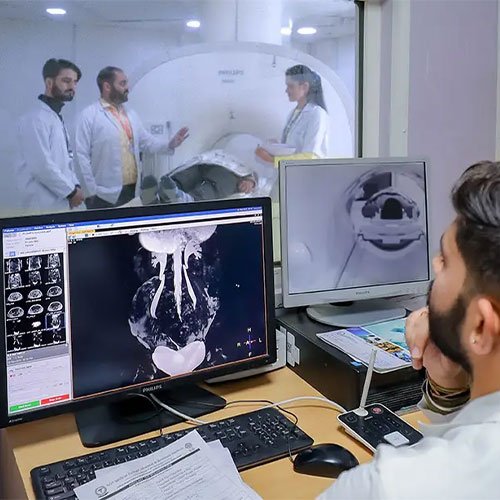
Radiology
Radiology
Radiology is a branch of medicine that uses imaging techniques to diagnose and treat diseases within the body. It plays a vital role in modern healthcare by allowing doctors to see inside the body without surgery, enabling accurate diagnosis and monitoring of various conditions. Radiologists, the doctors who specialize in this field, interpret the images generated by radiological procedures and work closely with other specialists to ensure effective patient care.
Radiology continues to advance with technologies such as artificial intelligence, which aids in faster and more accurate diagnoses. The field’s diversity in imaging methods and its integration with medical treatments make radiology an indispensable part of healthcare.

Key Areas of Radiology
Diagnostic Radiology
- This is the most common area within radiology, focusing on non-invasive imaging techniques to diagnose diseases. Common modalities include X-ray, MRI, CT scans, and ultrasound. Diagnostic radiologists analyze images to identify diseases, fractures, tumors, and other medical conditions.
Interventional Radiology
- Interventional radiologists use imaging guidance to perform minimally invasive procedures. This area involves the use of real-time imaging techniques, such as fluoroscopy, CT, or ultrasound, to guide procedures like angioplasty, stent placement, and biopsies. Interventional radiology often provides alternatives to open surgery, leading to reduced risk and faster recovery times for patients.
Nuclear Medicine
- Nuclear medicine involves the use of small amounts of radioactive materials to diagnose or treat diseases. Techniques like PET scans and SPECT scans are common in this area, as they allow radiologists to observe metabolic processes within the body. Nuclear medicine is often used in oncology to identify and monitor cancerous tissues.
Ultrasound
- Ultrasound imaging uses high-frequency sound waves to produce images of structures within the body. It’s a versatile tool widely used in obstetrics to monitor pregnancies, but also in diagnosing issues with organs, muscles, and blood vessels. Ultrasound is non-invasive, safe, and widely available.
Mammography
- Mammography is a specialized form of X-ray imaging used to detect breast cancer in its early stages. Screening mammograms are an essential preventive tool in women’s health, enabling the detection of abnormal tissue growth before symptoms arise.
Pediatric Radiology
- Pediatric radiology focuses on imaging for infants, children, and adolescents. This area considers the unique needs of younger patients and uses specialized approaches to ensure their safety and comfort. Pediatric radiologists often handle congenital anomalies, pediatric tumors, and trauma cases.
Musculoskeletal Radiology
- This branch focuses on the imaging of bones, joints, and soft tissues. It’s instrumental in diagnosing conditions like fractures, arthritis, and sports-related injuries. Techniques like MRI and CT scans are commonly used for detailed imaging of musculoskeletal structures.
Cardiovascular Radiology
- Cardiovascular radiology specializes in the imaging of the heart and blood vessels. Techniques include angiography, CT angiography, and MRI angiography, which help diagnose cardiovascular conditions such as blockages, aneurysms, and structural abnormalities.
Emergency Radiology
- Emergency radiologists work in acute settings, such as emergency rooms, to provide rapid imaging assessments for trauma patients. They help identify life-threatening conditions, such as internal bleeding or organ damage, and are essential for prompt treatment decisions.
Oncologic Radiology
- Oncologic radiology focuses on the detection, diagnosis, and monitoring of cancer. Imaging techniques like CT, MRI, PET, and ultrasound are used to locate tumors, evaluate their size and spread, and assess responses to treatments.
